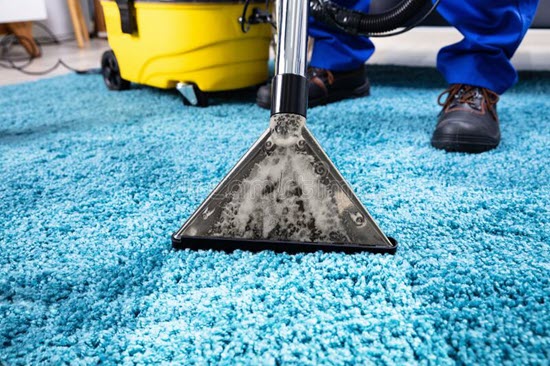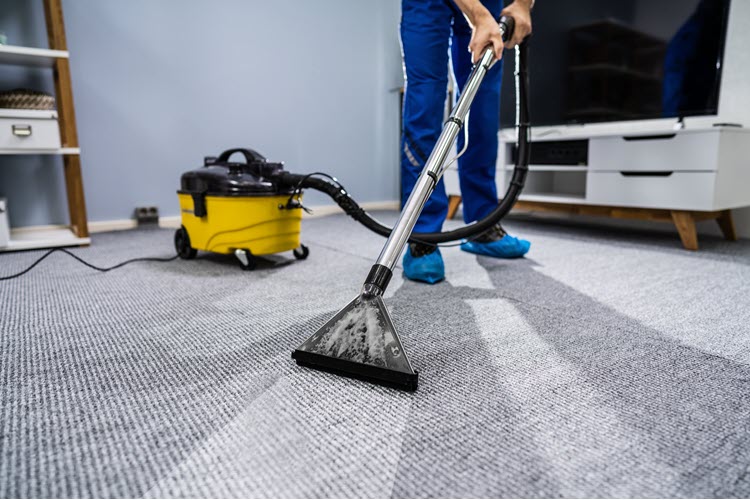It’s tempting to vacuum a wet carpet after a spill, but is it wise? Whether from an untimely spill, a burst pipe, or a flooding from a storm, it’s essential to dry carpets quickly. Whatever the source, you want to quickly remove moisture from your carpets to prevent mold development, which can ruin your flooring and require you to replace it or risk health consequences.
In This Article
What Happens if You Vacuum a Wet Carpet?
Household vacuums are insufficient at vacuuming up liquids, and you risk the potential of destroying your vacuum’s motor and potentially electrocuting yourself. Further, water will pass into the vacuum’s filters, ruining them and potentially risking mold growth if the filter remains in the machine.
However, you can vacuum a wet carpet with a wet/dry vacuum or a shop vacuum. They are relatively affordable to rent if you don’t own a wet/dry vacuum or commercial vacuum.
How to Vacuum a Wet Carpet
Preparing Your Shop Vacuum to Suction Liquids
Check your wet vacuum’s manufacturer instructions to determine which filter is appropriate for liquids. If unsure or you cannot find this information, remove the filter. Vacuuming liquids through a dry filter will ruin the filter and can lead to mold and mildew growth within the filter. It’s better to clean wet carpets without a filter than pass liquids through a dry filter.
- Remove the bag from the blower unit of your shop vacuum. The bag collects dry material like dust, dirt, and debris so liquids can damage it.
- The best nozzle for water suction on your shop vacuum is the wide, flat water nozzle. This attachment will help you get the most out of your vacuum’s suction power over flat surfaces like floors. You can use other nozzles, but a wide nozzle will make the quickest work of the task.
- Use a GFCI outlet when vacuuming up liquids. This type of outlet will trip off if there’s a power surge, which is always possible when mixing water with electricity. If the room you are working in lacks one (these outlets are usually found in kitchens and baths), you can buy an inexpensive plug-in version. You can still do the job without a GFCI outlet; be cautious.
- Remove the furniture from the affected area of the carpet. Liquids can seep into the carpet beneath your chairs, sofas, and tables. Move them away from the impacted area to ensure proper drying. Leaving them in place opens up potential carpet damage from mold and mildew growth.
- Resist the temptation to add extensions to your hose. While it can be a pain to haul around the vacuum tank, extensions reduce the suction power of your hose and will make the job slower and less efficient.

Vacuuming Wet Carpet in 6 Easy Steps
- Turn on the vacuum.
- Place the nozzle head below the water level or against the carpet. Suction until that area is free of water, then move the nozzle head to the next wet area.
- Pay attention to the amount of water you are suctioning up. Motor speeds change as the tank nears full. If you hear the sound of the motor change, check the water level.
- When emptying the tank, remove large debris from the water first before you dump the liquid out.
- Dispose of water in a safe location. If you are unsure if the water is safe to dispose of in your yard, you can contact your city or county’s waste services. Some offer water reclamation facilities, and many can advise you on how to dispose of potentially contaminated liquids.
- Once you have finished vacuuming the carpet, clean out the tank for your shop vacuum. One gallon of water mixed with 1/4 cup of household bleach will help you kill mold or mildew. Once the tank is thoroughly cleaned, rinse it with a hose and let it rest in a well-ventilated area upside down to dry. Hang the rinsed hose to ensure no standing water remains inside. Only store the machine after it has had sufficient time to dry completely.
A Note on Vacuuming Standing Water:
Shop vacuums have a capacity ranging from one to twenty gallons, with most falling between the four- to the ten-gallon range. Make a note of your vacuum’s capacity and be prepared to empty it often. You will likely fill the tank quickly if you are tackling standing water. If you are concerned about containments in the water, wear proper protection to protect your skin and eyes and masks against airborne risks where necessary. If you are worried about contaminants in standing water, a professional restoration company is worth considering, as they have the expertise and equipment to recover your flooring without risk.
How to Dry Wet Carpet
Once again, you should never vacuum a wet carpet with your household vacuum. If you want to vacuum wet carpets, you’ll need to rent or buy a shop vacuum or commercial vacuum. Once you’ve suctioned up as much excess water as the shop vac can address, you may still have a damp carpet. Follow these steps to finish the drying process. You can also use these if you don’t have a wet vac and want to deal with mild spills or a carpet damp from shampooing.
How to Dry Wet Carpet Without Vacuum
- Sop up excess moisture using towels.
- Turn on the fans. Your overhead fan is best, but an oscillating floor model will also help.
- Open windows. Good ventilation and airflow will help speed up the drying process.
- Use a dehumidifier. The dehumidifier will help sap excess moisture from the air and speed up drying; this works best with fans going.
- Baking soda helps if you lack a dehumidifier by absorbing excess moisture. Sprinkle liberally over the impacted area, wait thirty minutes, then vacuum up the dry residue.
Frequently Asked Questions:
What happens if you vacuum something wet?
Vacuuming up liquids can result in ruined filters and a soggy mess, a damaged motor, or potential electrocution if you use your household vacuum. Only use a shop vacuum or wet/dry vacuum to tackle liquids in your carpet.
Does vacuuming wet carpet help it dry?
The short answer is yes. A wet/dry or shop vacuum can help you pull excess moisture from the carpet. The more water you can remove through safe vacuuming, the faster the drying process will go. Vacuuming with a wet/dry or shop vacuum will not completely dry carpets, but it will significantly speed up the process.
How can I dry my wet carpet faster?
The best method is a combination of air circulation and dehumidification, removing as much moisture as possible with a wet/dry vacuum or sopping up excess liquids with towels.
Can I vacuum a wet floor?
Not with your household vacuum, but you can with a shop or wet/dry vacuum. Make sure you remove the filter in your shop vacuum before you soak up liquids while vacuuming the floor.
How long does it take for mold to grow in wet carpet?
According to FEMA, mold starts to develop on a damp, organic surface like carpeting within 24-48 hours. It’s vital to understand that your carpet doesn’t need to be soaked to create a breeding ground for mold. A damp carpet can still be susceptible to mold damage. If your carpet has been wet for more than two days, you are advised to remove and replace the carpet and the underlying padding.
How long does it take wet carpet to dry?
How long the carpet takes to dry depends on several factors. If you live in an arid region, the temperature is warm, and you have good airflow in the room, a slightly damp carpet can take six to ten hours to dry. If you live in a humid region with cooler temperatures, your room has limited airflow, and the carpets are soggy, it can take significantly longer. In these conditions, you risk mold developing without speeding the process along.
Will wet carpet dry on its own?
A wet carpet will, eventually, dry on its own. However, it may need to dry faster to avoid permanent damage, particularly the development of mold that will render your carpet unsafe and force you to replace it. Damp carpets may dry without further intervention though it will still take anywhere from four hours to four days, depending on several factors.
If you are in a humid area and your room lacks good ventilation, you will want to help the process along to keep your carpets healthy.
How do you soak up water from carpet?
Aside from using a wet/dry vacuum or shop vacuum, there are two primary ways to sop up a spill or excess water from a carpet. The first is with towels. Blot to absorb the excess moisture, replacing the towel with a fresh one when it becomes sodden. The second involves baking soda, which is highly absorbent. Sprinkle baking soda liberally over the damp area and let it rest for 30 minutes. Once it’s finished absorbing the liquid, you can vacuum it up.
Final Thoughts on Vacuuming a Wet Carpet
Vacuuming up water is an efficient way to help speed up the drying process of wet carpets. The process is simple as long as you use the right equipment. With the right approach, you can restore wet carpets without risk of mold or mildew damage.


